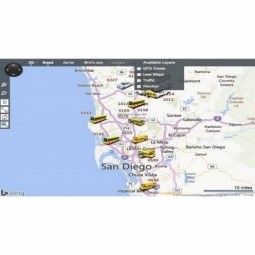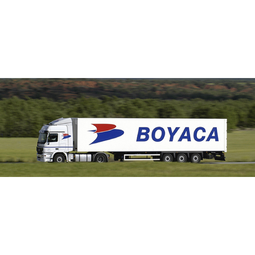Overview
 |
Fleet Management |
Applicable Industries
Applicable Functions
Case Studies
Market Size
|
The fleet management market size is expected to grow from USD 13.78 billion in 2017 to USD 28.66 billion by 2022, at a Compound Annual Growth Rate (CAGR) of 15.8%. Source: Markets and Markets Fleet Management Market was valued at $7,755 million, and is expected to reach $34,629 million by 2022. Source: Global Opportunity Analysis and Industry Forecast, 2014 - 2022 The global smart fleet management market size is expected to reach USD 565.1 billion by 2025. The market is anticipated to register a CAGR of 7.6% from 2017 to 2025. Source: Grand View Research |
Business Viewpoint
|
What value do fleet management systems provider to fleet operators? 1. Monitoring and reacting to road conditions For fleet managers that rely on accurate weather forecasting to allocate and deploy vehicles, having up-to-date weather information is critical to ongoing operations. For impacts on road conditions, IoT data can be used in a variety of ways. IoT sensors can collect a myriad of road weather data. All this data is transmitted in real-time, cloud-based software, and then filtered down and pushed to a data dashboard. 2. Monitor and optimize vehicle health Although a primary use of IoT data in a fleet management system is generating hyper-local real-time data for road conditions, an important secondary use of a fleet solution is to assist in proper vehicle maintenance. 3. Provide management with actionable insights An IoT fleet solution collects the data that fleet managers need to properly allocate and deploy resources. The data generated by an IoT fleet monitoring system also keeps your fleet operators safe. Utilizing a properly configured fleet management system they can see the health and deployment of their operations in real-time, and more efficiently allocate assets where they need them and when they need them.
|
Stakeholder Viewpoint
|
Who are the stakeholders in the context of an international fleet policy? You may need to link with many different types of stakeholders. - Stakeholders at the corporate level: Finance, HR, other project teams Who are the internal stakeholders in fleet and transport management? - Department of transport - HoD (Accounting officer) - Head of Supply Chain - CFO - Transport officer - Drivers Who are the external stakeholders in fleet and transport management? - Suppliers - Society - Government - Creditors - Shareholders - Customers
|
Technology Viewpoint
|
What technologies are used on fleet management for vehicles? Vehicles use telematics like GPS for reliable global automatic vehicle location (AVL) detection, though some use GLONASS or less expensive cellular triangulation in remote and less-traveled areas. Although commonly associated with delivery cars and trucks, the boating industry uses fleet management technology as well. What features are important in fleet management technology? 1. Connectivity: right connection to drivers and workers, companies can leverage their fleet as efficiently as possible. 2. Screen the most important information: fleet operators must strive to achieve the lowest possible total cost of ownership (TCO) for their fleets while complying with increasingly stringent environmental and safety regulations. Fuel consumption, route management, driver performance, and vehicle maintenance all play a part in this goal. 3. Monitoring systems: gather valuable data regarding the real-time location and management of the fleet and the complete history of activities of the vehicles. Doing so, it enables to control the activities of the company in order to promote efficiency, encourage customer-satisfaction and increase profitability. 4. Cloud-based software (Software-as-a-Service): these software solutions can assist with common tasks such as scheduling, fleet maintenance, IFTA compliance, route planning, and load optimization. 5. Weather forecasting technology is great for providing a rough idea of what the weather will be like over a period of time.
|
Data Viewpoint
|
What data can we get thanks to fleet management? 1. Driver behavior: by combining received data from the vehicle tracking system and the onboard computer, it is possible to form a profile for any given driver (average speed, the frequency of detours, breaks, the severity of maneuvers, etc.). 2. Mechanical diagnostics: an advanced fleet management systems (FMS) can connect to the vehicle's onboard computer, and gather data for the user. Data such as mileage and fuel consumption are gathered into a global statistics scheme. 3. Fleet management software: it allows functions such as recording driver and vehicle details, the tracking of procurement costs, scheduling of maintenance and servicing tasks, import of fuel transactions, and measuring of fleet performance via reports and charts. 4. Fleet security and control: it includes security of the vehicle while stopped or not in operation and the ability to safely disable a vehicle while in operation.
|
Deployment Challenges
|
What challenges must fleet managers address? 1. Avoiding information overload: fleet management software provides tools to cope by filtering all the information. This helps fleet managers stay in control at all times without the need to spend all day going cross-eyed over detailed reports. 2. Integrating fleet data into existing software systems: integration with other software systems is handled through APIs. This allows a developer to quickly and easily let existing systems communicate with fleet management software. 3. Making sure all assets are fully utilized: GPS tracking makes sure that all vehicles are accounted for and being utilized efficiently. Fleets often find GPS fleet tracking provides them with accurate information they need to make profitable decisions. 4. Finding specific fleet information quickly: vehicles, drivers, and teams can all be tagged with meaningful labels for rapid reporting. 5. Use software systems that are scalable and able to handle rapid growth. 6. Fuel price volatility is a major factor impacting planned fleet budgets. What regulatory challenges could impact deployment? Being able to prove compliance with all applicable regulations that cover fleet activities is a key element of fleet management, and everything from vehicle registration and insurance, to operator licensing and certification, to driving logs and inspection reports, should be easily accessible.
|





